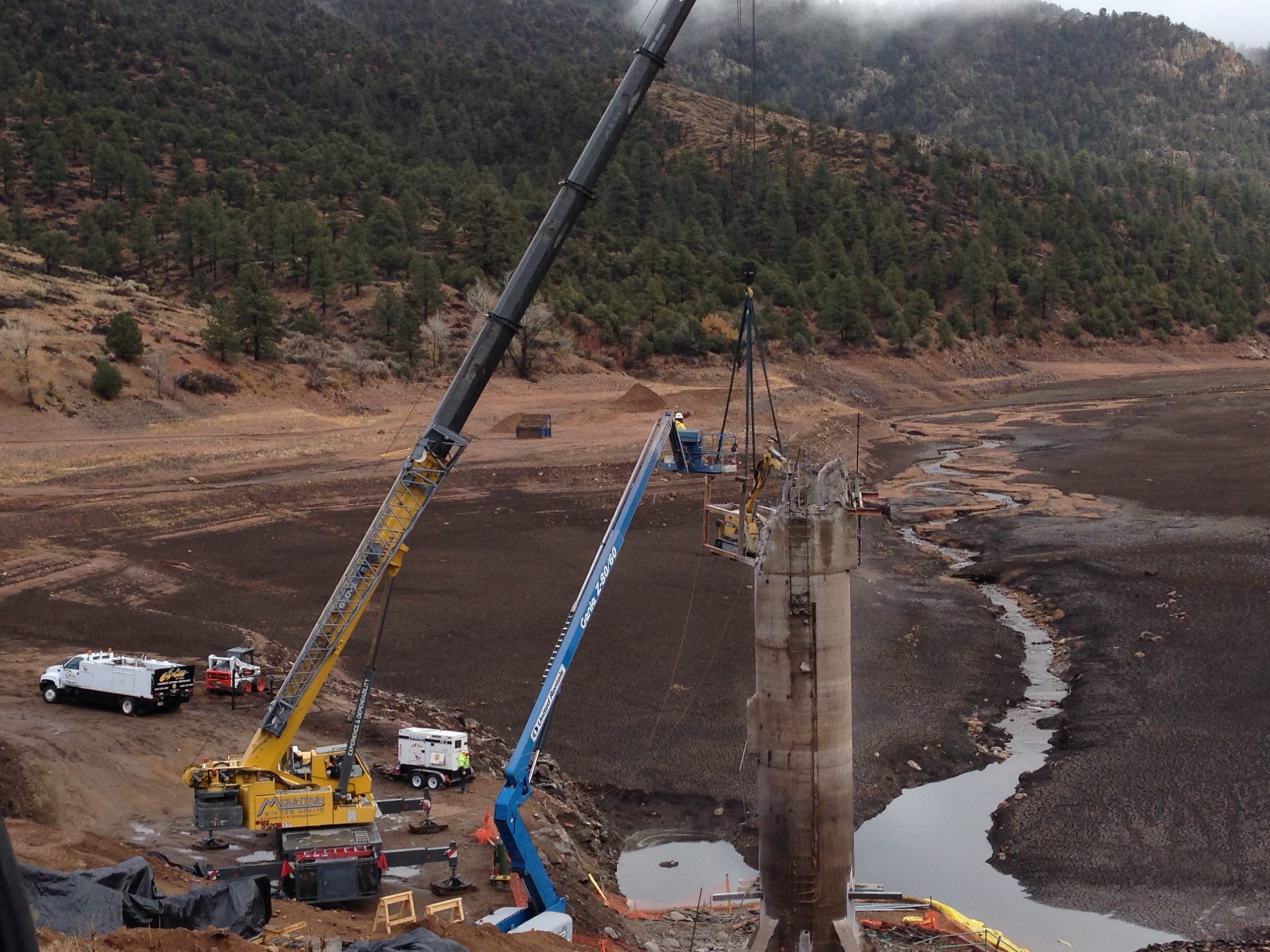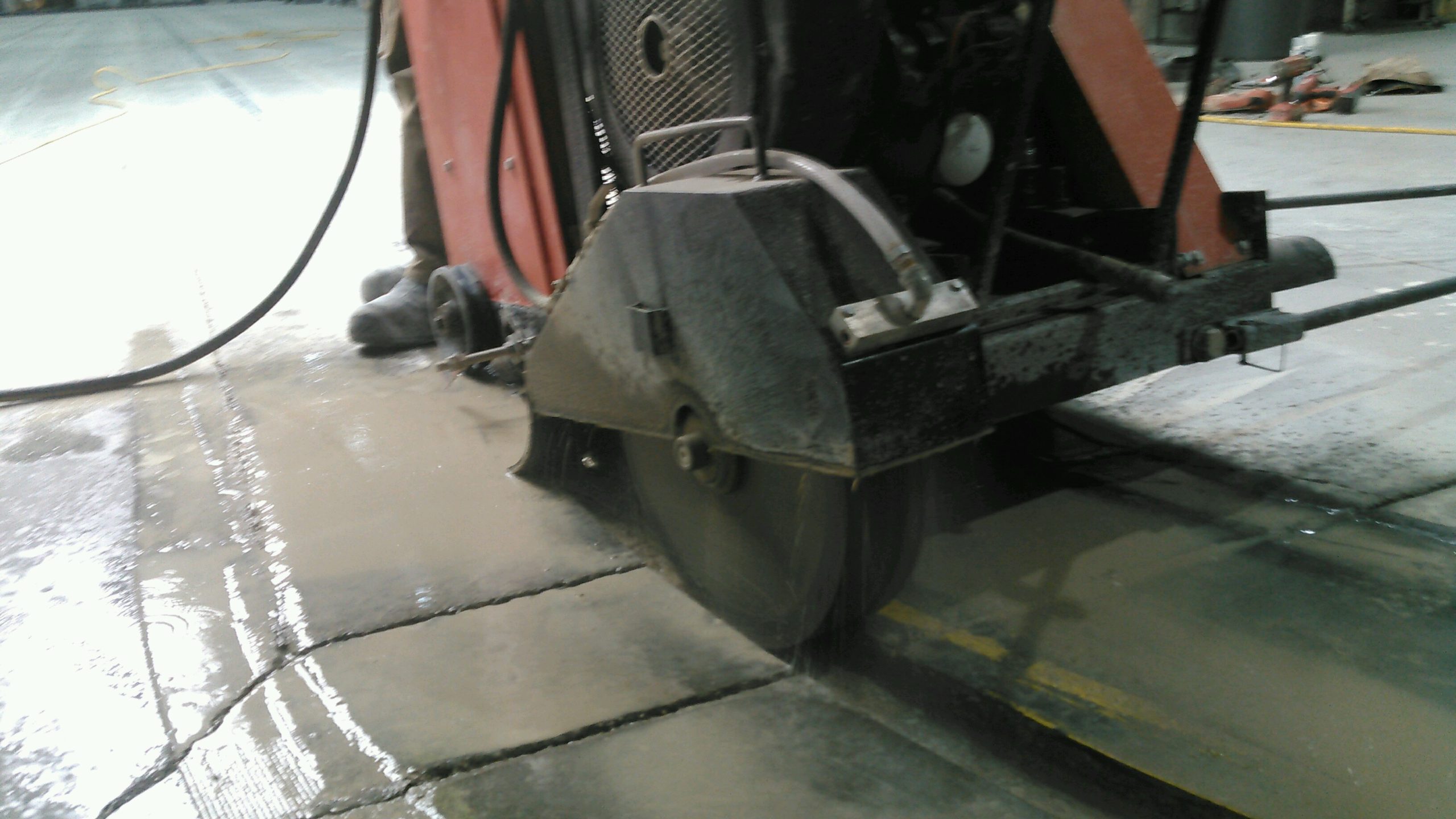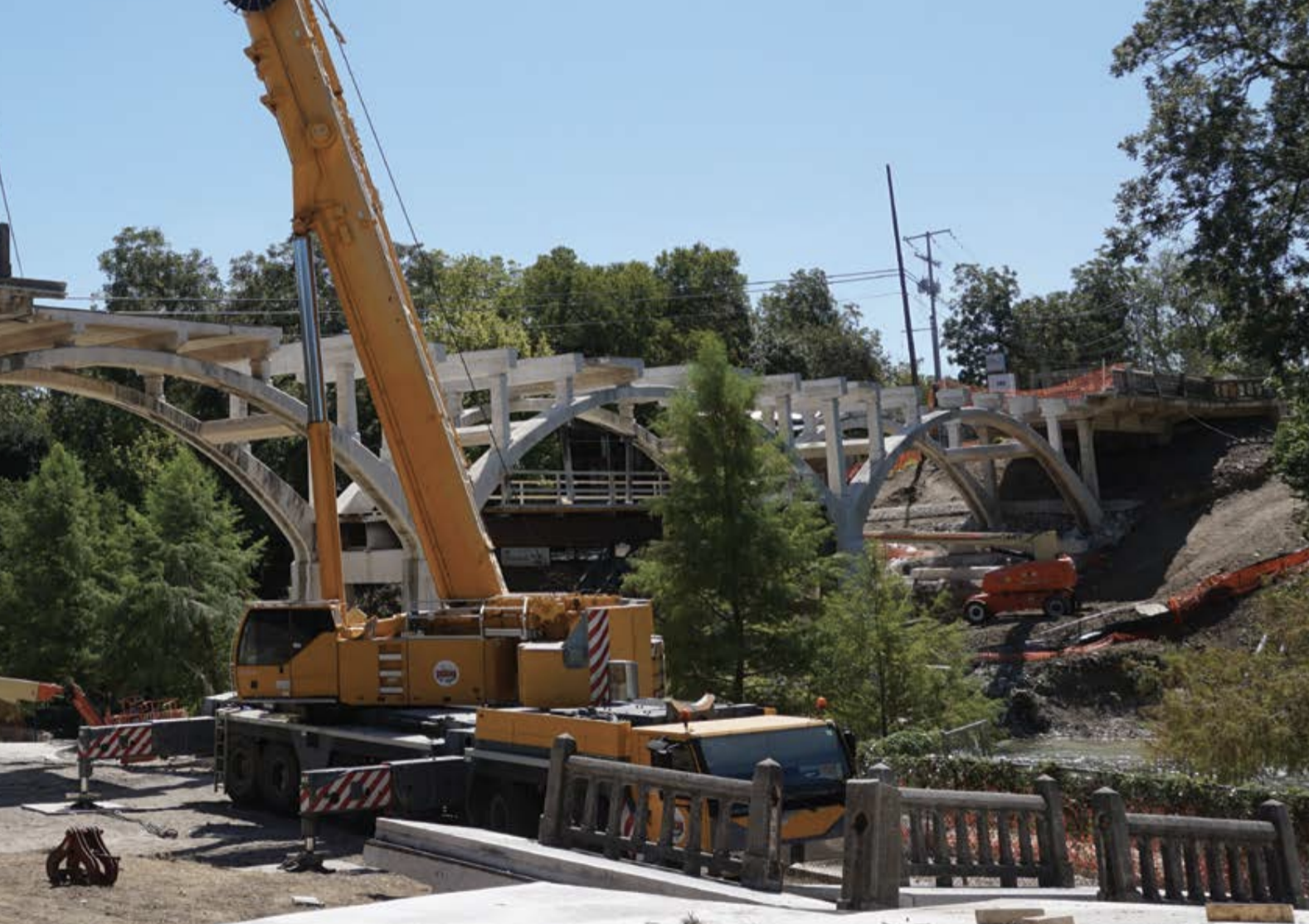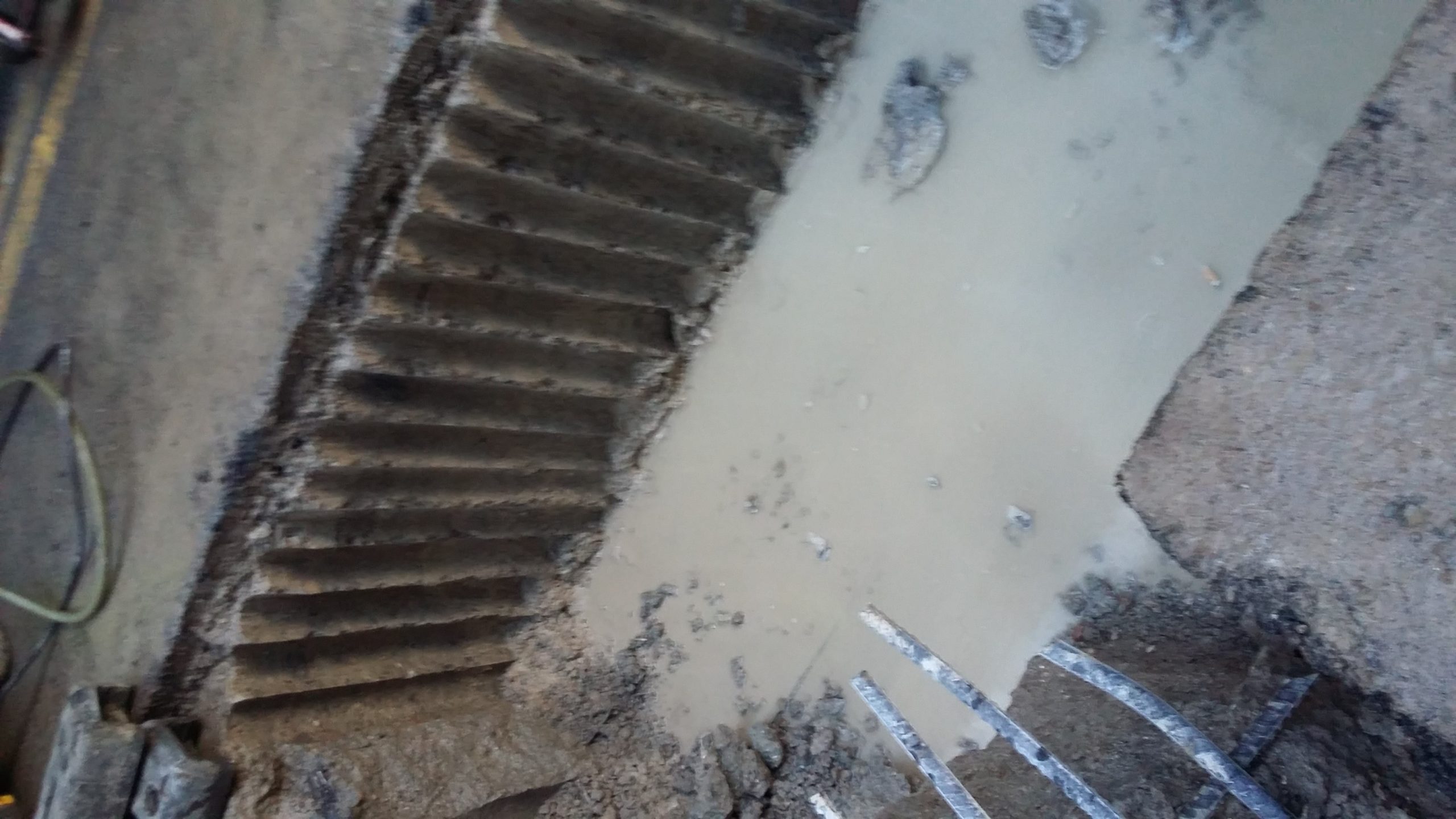
Without Wasting a Drop

Robotic Demo Brings Down Aging Water Silos
(Click Here to see a video of the work)
When a demolition contractor faced demolishing two aging concrete silos standing precariously over Santa Fe, New Mexico’s water supply, they knew they had to be innovative. The water intake structures sat in the Nichols and McClure reservoirs on the Santa Fe River and supplied 40 percent of the area’s drinking water.
To adjust water flow through dams and into the water treatment plant, city workers took small boats across the reservoirs and climbed rickety ladders to the top of the silos, built in the 1940s, to open or close the valves. It was inefficient and dangerous.
In 2014, city engineers came up with a $6 million plan to modify the silos and allow workers easier access. The designs included connecting the inlet structures to intakes that would run up the sides of the dams. The city planned to alternate draining the two reservoirs over two years to not interrupt the flow of drinking water. They hired contractors to demolish the silos down to the inlet structures at the base so crews could construct a new system.

An operator core drilled 12-inch-diameter holes through one of the silos to insert a steel beam for a work platform.
Santa Fe hired general contractor RMCI Inc., based in Albuquerque, New Mexico. RMCI brought experience in water supply-related construction and could build the new intake structures, but the team lacked the tools and expertise to cut the silos down without damaging the bases. They connected with A-Core Inc., a Salt Lake City-based CSDA member with an office in Albuquerque, New Mexico. The contractor has extensive experience using innovative methods for concrete cutting, demolition and wire sawing.
The logistics of getting equipment to the sites was the contractor’s immediate challenge. The first silo in Nichols Reservoir could only be reached by traveling 2 miles up a narrow, winding dirt service road. McClure is another 3 miles up. RMCI widened the road and put steel plates on some turns for stability to accommodate trucks, equipment and a 120-ton crane. Still, the road wouldn’t allow large trailers, so much of the equipment was transported by front-end loaders or on small trailers. Weather complicated things even more. The cutting and demolition contractor couldn’t work for a number of days because rain made it dangerous to get up or down the mountain. The crew also had to be conscious of noise at the service road entrance, which was near a bird sanctuary with protected species.
“It was slow going,” said A-Core Demolition Division Manager Ray Chavez. “We crept up the mountain with our equipment. We used an 85-foot boom lift for the project and couldn’t bring it up on a trailer, so we drove it the whole way while hugging the mountain. It took an entire day.”
The difficulties didn’t stop when the crew reached the top. While Nichols Reservoir had clear access roads making it easy to get to the bottom, the older McClure Reservoir did not. The area had been under water for many years, so finding a way down to the silo without disturbing the face of the dam was a daunting task. Santa Fe city engineers found a solution in the archives.
“They found these old black and white photos taken when they built the reservoir,” Chavez said. “We looked at the pictures to see the access roads they used back then and used that information to plan our route.”

The demo robots were powerful enough to break the concrete, but precise enough to not cause micro-fracturing in the inlet structure below.
Like the journey to the jobsite, demolishing the silos was not straightforward. Aside from needing to not damage the inlet structures, the contractor had to be careful not to contaminate the drinking water flowing beneath them. The Nichols Reservoir silo, the first to be demolished, was about 65 feet tall and had to be brought down to a 25-foot buried inlet section. Measuring 10 feet in diameter, the walls of the silo were 2.5-foot-thick concrete reinforced by rebar, steel plates, angle iron and embedded gate valves. The McClure Reservoir silo was 35 feet taller and had to be brought down to another 25-foot buried inlet structure. The silo was 8 feet across with 2-foot-thick concrete walls that had the same embedded steel obstacles as Nichols.
Project planners devised a plan to build scaffolding around the silos and wire saw 6-foot sections before removing them with a crane piece by piece, but Chavez said it was too risky and dangerous.
“The silos were old and deteriorating. I thought that if we tried to lift the sections, the concrete might break apart and put our crew, equipment and the inlet structure in danger,” Chavez said. “We would have had the same problem if we tried to use explosives or larger equipment. We proposed a faster and safer method.”
Based on past experience at a similar job, Chavez convinced the city to go a different route that would fit the existing budget. A-Core planned to attach the company’s remote-controlled Brokk demolition machine to the crane, lift it into the air and carefully chip away at the silos. That plan would allow A-Core to work from the top down, using the machine’s precision demolition abilities to avoid vibrations that other methods would have caused and, in turn, led to micro-fracturing the inlet structures.
The contractors needed to follow strict EPA drinking water rules. Before demolition could begin, they had to prevent debris or dust from falling into the waterway beneath the silos or onto the outer part of the inlet structures. The water treatment plant downstream monitored the water constantly for any changes during the project.
“We also had to make sure our equipment was in excellent shape and wouldn’t leak,” Chavez said. “We always had spill kits on hand, used food-grade hydraulic fluid and inspected our equipment often.”

The demo robot was controlled from a boom lift platform about 25 feet away.
A-Core determined the best way to contain the debris inside the silos was to build watertight platforms at the elevation they planned to stop hammering. They used Weka and Diamond Product core drills to create 12-inch diameter holes on one side of the silos and 14-inch holes on the other. The crew slid two 10-inch square tube steel beams through to create a base. Then, they core drilled a 30-inch-diameter access hole above the beams. Workers built platforms out of wooden planks that they waterproofed with backer rod before sealing everything with plastic, duct tape and spray foam. Crews buried the inlet structures to control debris from the outside and created working platforms about 40 feet in diameter lined with snow fences.
RMCI cut a crane pad into the side of the reservoir about a quarter of the way up the silo to get the demolition robot and its operator to the proper height. Crews first tried using a Brokk 180, a medium-sized demolition robot, for the Nichols silo. A-Core secured the machine to their custom steel platform and used the crane to lift the platform and machine to the top of the structure. The operator stood on the boom lift platform, staying a safe 25 feet away while using the demolition-robot’s remote-control box to direct the machine’s three-part arm with an Atlas Copco breaker attached.
It was soon apparent that the Brokk 180 wasn’t chipping away at the concrete fast enough. Chavez was prepared for that possibility and brought along a larger Brokk 330D as backup. The crew switched the machines and used the 330D’s 700 foot-pounds of power to break away at the structure.
“Work moved much faster after we switched machines,” Chavez said. “The demolition machine provided just enough power and precision to break the concrete, but not so much that it could damage the structure below. The only times we had to slow down was every 10 or 12 feet, when we had to stop breaking and use Husqvarna and Stihl hand saws to remove rebar.”
Crews stopped 6 or 8 feet above the cut-off point on each silo to prevent any possibility of damaging the inlet structure. Then, A-Core used Husqvarna wire saws to cut the remaining concrete and leave a clean finish at the required elevation. All cut sections were removed by crane. The contractor also spent two days in the McClure reservoir wire sawing off a horseshoe-shaped wall at the foot of the silo that was more than 6 feet thick. The wall allowed space for water to flow into the inlet structure. A-Core removed it to make way for the new structure RMCI was building.
The Nichols silo took about 2.5 weeks of actual breaking time to complete. The McClure silo took about 2 weeks. Chavez said the first was a learning curve and the extra half-foot of concrete in the walls made it more difficult. In the end, A-Core hauled away more than 600 tons of concrete.
Once the demolition was done, RMCI added the new intake structures and the city refilled the reservoirs, completing the Nichols reservoir in July 2014 and McClure in May 2015.
City workers can now adjust the valves by opening a door at the top of either dam and walking down a flight of stairs.
The project was on time and on budget with no safety issues or injuries. The job also strengthened A-Core’s relationship with RMCI and opened the door to new projects. It was a project made successful by creative thinking and innovative tools.
Company Profile
Based in Salt Lake City, Utah, A-Core Inc. has been in business since 1974. The company joined CSDA in the 1970s and company owner Jack Johnson served as CSDA President in 1988. A-Core Inc. offers the concrete services of concrete sawing and drilling, diamond wire sawing, concrete grinding and grooving, specialized soft and heavy demolition, joint sawing and sealing and concrete rehabilitation. A-Core has 10 offices, more than 250 employees and services states west of the Mississippi River.
Resources
General Contractor:
RMCI Inc.
Sawing and Drilling Contractor:
A-Core Inc.
Salt Lake City, Utah
Phone: 801-261-5552
Email: info@a-core.com
Website: www.a-core.com
Methods Used: Core Drilling, Wire Sawing, Selective Demolition














